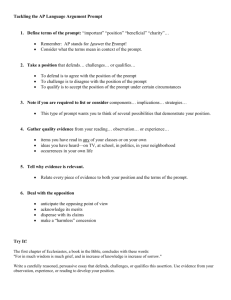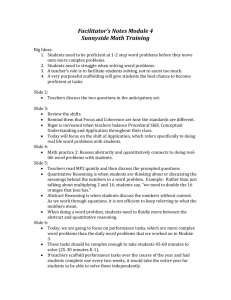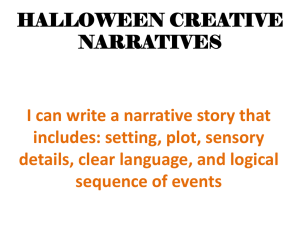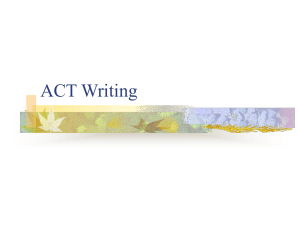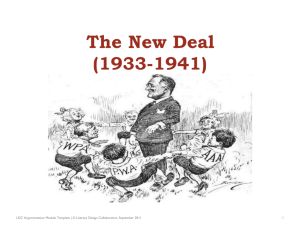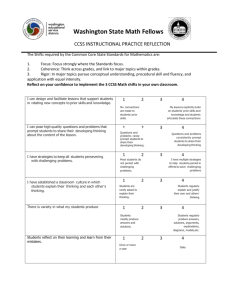The American Revolution:
advertisement
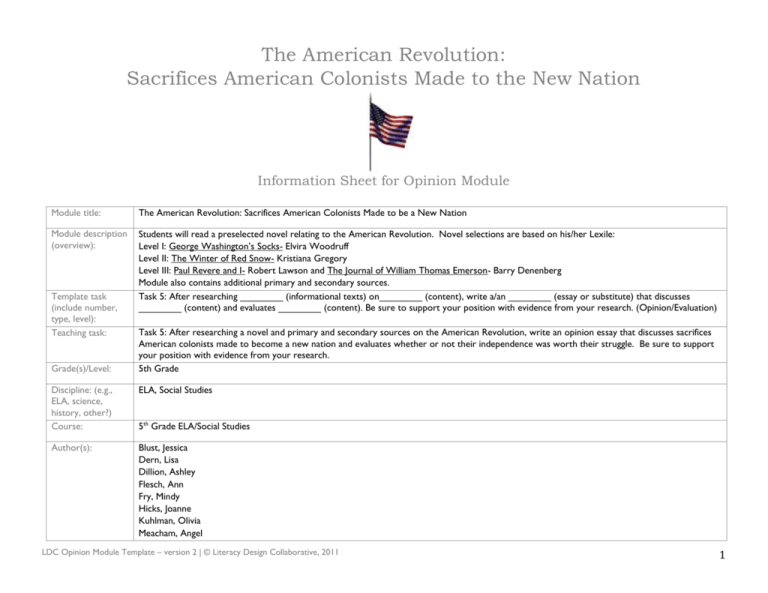
The American Revolution: Sacrifices American Colonists Made to the New Nation Information Sheet for Opinion Module Module title: The American Revolution: Sacrifices American Colonists Made to be a New Nation Module description (overview): Students will read a preselected novel relating to the American Revolution. Novel selections are based on his/her Lexile: Level I: George Washington’s Socks- Elvira Woodruff Level II: The Winter of Red Snow- Kristiana Gregory Level III: Paul Revere and I- Robert Lawson and The Journal of William Thomas Emerson- Barry Denenberg Module also contains additional primary and secondary sources. Task 5: After researching ________ (informational texts) on________ (content), write a/an ________ (essay or substitute) that discusses ________ (content) and evaluates ________ (content). Be sure to support your position with evidence from your research. (Opinion/Evaluation) Template task (include number, type, level): Teaching task: Grade(s)/Level: Task 5: After researching a novel and primary and secondary sources on the American Revolution, write an opinion essay that discusses sacrifices American colonists made to become a new nation and evaluates whether or not their independence was worth their struggle. Be sure to support your position with evidence from your research. 5th Grade Discipline: (e.g., ELA, science, history, other?) Course: ELA, Social Studies Author(s): Blust, Jessica Dern, Lisa Dillion, Ashley Flesch, Ann Fry, Mindy Hicks, Joanne Kuhlman, Olivia Meacham, Angel 5th Grade ELA/Social Studies LDC Opinion Module Template – version 2 | © Literacy Design Collaborative, 2011 1 Contact information: Milar, Ashley Murray, Ally Lohmoeller, Becky Phillips, David Reynolds, Lisa Schmidlin, Kristen Stenger, Becky Thompson, Emily jessica.blust@kenton.kyschools.us lisa.dern@kenton.kyschools.us ashley.dillion@kenton.kyschools.us ann.flesch@kenton.kyschools.us mindy.fry@kenton.kyschools.us kristen.schmidlin@kenton.kyschools.us ashley.milar@kenton.kyschools.us olivia.kuhlman@kenton.kyschools.us david.phillips@kenton.kyschools.us lisa.reynolds@kenton.kyschools.us angel.meacham@kenton.kyschools.us rebecca..stenger@kenton.kyschools.us joanne.hicks@kenton.kyschools.us rebecca.lohmoeller@kenton.kyschools.us allyson.murray@kenton.kyschools.us emily.thompson@kenton.kyschools.us Section 1: What Task? TEACHING TASK Background to share with students: Task 5: After researching a novel and primary and secondary sources on the American Revolution, write an opinion essay that discusses sacrifices Teaching task: American colonists made to become a new nation and evaluates whether or not their independence was worth their struggle. Be sure to support your position with evidence from your research. Reading texts: Level 1: George Washington’s Socks Level II: The Winter of Red Snow Level III: Paul Revere and I and The Journal of William Thomas Emerson Extension Johnny Tremaine video clip (optional): Loyalists and Patriots play: https://emerson.digication.com/meganalexander/Patriots_vs._Loyalists_A_5th_Grade_debate Molly Pitcher: http://library.thinkquest.org/TQ0312848/mpitcher.htm LDC Opinion Module Template – version 2 | © Literacy Design Collaborative, 2011 2 COMMON CORE STATE STANDARDS “Built-in” Reading Standards READING STANDARDS FOR OPINION “When Appropriate” Reading Standards 1- Read closely to determine what the text says explicitly and to make logical inferences from it; cite specific textual evidence when writing or speaking to support conclusions drawn from the text. 3- Analyze how and why individuals, events, and ideas develop and interact over the course of a text. 2- Determine central ideas or themes of a text and analyze their development; summarize the key supporting details and ideas. 5- Analyze the structure of texts, including how specific sentences, paragraphs, and larger portions of the text (e.g., section, chapter, scene, or stanza) relate to each other and the whole. 4- Interpret words and phrases as they are used in a text, including determining technical, connotative, and figurative meanings, and analyze how specific word choices shape meaning or tone. 6- Assess how point of view or purpose shapes the content and style of a text. 10- Read and comprehend complex literary and informational texts independently and proficiently. 7- Integrate and evaluate content presented in diverse formats and media, including visually and quantitatively, as well as in words. 8- Delineate and evaluate the argument and specific claims in a text, including the validity of the reasoning as well as the relevance and sufficiency of the evidence. 9- Analyze how two or more texts address similar themes or topics in order to build knowledge or to compare the approaches the authors take. “Built-in” Writing Standards WRITING STANDARDS FOR OPINION “When Appropriate” Writing Standards 1- Write Opinions to support claims in an analysis of substantive topics or texts, using valid reasoning and relevant and sufficient evidence. 2- Write informative/explanatory texts to examine and convey complex ideas and information clearly and accurately through the effective selection, organization, and analysis of content. 4- Produce clear and coherent writing in which the development, organization, and style are appropriate to task, purpose, and audience. 3- Write narratives to develop real or imagined experiences or events using effective technique, well-chosen details, and well-structured event sequences. 5- Develop and strengthen writing as needed by planning, revising, editing, rewriting, or trying a new approach. 6- Use technology, including the Internet, to produce and publish writing and to interact and collaborate with others. 9- Draw evidence from literary or informational texts to support analysis, reflection, and research. 7- Conduct short as well as more sustained research projects based on focused questions, demonstrating understanding of the subject under investigation. 10- Write routinely over extended time frames (time for research, reflection, and revision) and shorter time frames (a single sitting or a day or two) for a range of tasks, purposes, and audience. 8- Gather relevant information from multiple print and digital sources, assess the credibility and accuracy of each source, and integrate the information while avoiding plagiarism. LDC Opinion Module Template – version 2 | © Literacy Design Collaborative, 2011 3 TEACHING TASK RUBRIC (OPINION) Scoring Elements Focus Controlling Idea Reading/ Research Development Not Yet 1 Attempts to address prompt, but lacks focus or is off-task. Attempts to establish a claim, but lacks a clear purpose. (L2) Makes no mention of counter claims. Attempts to reference reading materials to develop response, but lacks connections or relevance to the purpose of the prompt. Attempts to provide details in response to the prompt, but lacks sufficient development or relevance to the purpose of the prompt. (L3) Makes no connections or a connection that is irrelevant to argument or claim. 1.5 Approaches Expectations 2 Addresses prompt appropriately and establishes a position, but focus is uneven. Establishes a claim. (L2) Makes note of counter claims. Presents information from reading materials relevant to the purpose of the prompt with minor lapses in accuracy or completeness. Presents appropriate details to support and develop the focus, controlling idea, or claim, with minor lapses in the reasoning, examples, or explanations. (L3) Makes a connection with a weak or unclear relationship to argument or claim. 2.5 Meets Expectations 3 Addresses prompt appropriately and maintains a clear, steady focus. Provides a generally convincing position. Advanced 4 Addresses all aspects of prompt appropriately with a consistently strong focus and convincing position. Establishes a credible claim. (L2) Develops claim and counter claims fairly. Establishes and maintains a substantive and credible claim or proposal. (L2) Develops claims and counter claims fairly and thoroughly. Accurately presents details from reading materials relevant to the purpose of the prompt to develop argument or claim. Accurately and effectively presents important details from reading materials to develop argument or claim. Presents appropriate and sufficient details to support and develop the focus, controlling idea, or claim. (L3) Makes a relevant connection to clarify argument or claim. Presents thorough and detailed information to effectively support and develop the focus, controlling idea, or claim. (L3) Makes a clarifying connection(s) that illuminates argument and adds depth to reasoning. Organization Attempts to organize ideas, but lacks control of structure. Uses an appropriate organizational structure for development of reasoning and logic, with minor lapses in structure and/or coherence. Conventions Attempts to demonstrate standard English conventions, but lacks cohesion and control of grammar, usage, and mechanics. Sources are used without citation. Demonstrates an uneven command of standard English conventions and cohesion. Uses language and tone with some inaccurate, inappropriate, or uneven features. Inconsistently cites sources. Demonstrates a command of standard English conventions and cohesion, with few errors. Response includes language and tone appropriate to the audience, purpose, and specific requirements of the prompt. Cites sources using appropriate format with only minor errors. Content Understanding Attempts to include disciplinary content in argument, but understanding of content is weak; content is irrelevant, inappropriate, or inaccurate. Briefly notes disciplinary content relevant to the prompt; shows basic or uneven understanding of content; minor errors in explanation. Accurately presents disciplinary content relevant to the prompt with sufficient explanations that demonstrate understanding. LDC Opinion Module Template – version 2 | © Literacy Design Collaborative, 2011 3.5 Maintains an appropriate organizational structure to address specific requirements of the prompt. Structure reveals the reasoning and logic of the argument. Maintains an organizational structure that intentionally and effectively enhances the presentation of information as required by the specific prompt. Structure enhances development of the reasoning and logic of the argument. Demonstrates and maintains a welldeveloped command of standard English conventions and cohesion, with few errors. Response includes language and tone consistently appropriate to the audience, purpose, and specific requirements of the prompt. Consistently cites sources using appropriate format. Integrates relevant and accurate disciplinary content with thorough explanations that demonstrate in-depth understanding. 4 Section 2: What Skills? SKILL DEFINITION SKILLS CLUSTER 1: PREPARING FOR THE TASK 1. Task engagement Ability to connect the task and new content to existing knowledge, skills, experiences, interests, and concerns. 2. Task analysis Ability to understand and explain the task’s prompt and rubric. SKILLS CLUSTER 2: READING PROCESS 1. Text selection Ability to identify appropriate texts. 2. Active reading Ability to identify the central point and main supporting elements of a text. L2 Ability to identify and analyze competing opinions. L3 Ability to make clarifying connections and/or provide examples. 3. Essential vocabulary Ability to identify and master terms essential to understanding a text. 4. Academic integrity Ability to use and credit sources appropriately. 5. Note-taking Ability to select important facts and passages for use in one’s own writing. SKILLS CLUSTER 3: TRANSITION TO WRITING 1. Bridging Ability to begin linking reading results to writing task. SKILLS CLUSTER 4: WRITING PROCESS 1. Claim Ability to establish a claim and consolidate information relevant to task. 2. Planning Ability to develop a line of thought and text structure appropriate to an opinion task. 3. Development Ability to construct an initial draft with an emerging line of thought and structure. L2 Ability to analyze competing opinions. L3 Ability to make clarifying connections and/or provide examples. 4. Revision Ability to refine text, including line of thought, language usage, and tone as appropriate to audience and purpose. 5. Editing Ability to proofread and format a piece to make it more effective. 6. Completion Ability to submit final piece that meets expectations. LDC Opinion Module Template – version 2 | © Literacy Design Collaborative, 2011 5 Section 3: What Instruction? PACING SKILL AND DEFINITION MINI-TASK PRODUCT AND PROMPT SKILLS CLUSTER 1: PREPARING FOR THE TASK 1. Task engagement KWL Chart on American Revolution Activity 1 Ability to connect the task and new content to existing knowledge, skills, experiences, interests, and concerns. Activity 1 2. Task analysis Ability to understand and explain the task’s prompt and rubric. Bullets In your own words, what are the important features of a good response to this prompt? SKILLS CLUSTER 2: READING PROCESS 3. Essential vocabulary Vocabulary list Ongoing Ability to identify and In your notebook, list words and phrases essential to the master terms essential to texts. Add definitions, and with PREP +, add notes on understanding a text. connotation in context. Activity 2 Active Reading http://www.mission-us.org/pages/landing-mission-1 Mission US Complete Mission 1: ‘For Crown or Colony’ LDC Opinion Module Template – version 2 | © Literacy Design Collaborative, 2011 INSTRUCTIONAL STRATEGIES SCORING (PRODUCT “MEETS EXPECTATIONS” IF IT…) Visually review charts to monitor completion. No scoring Lists appropriate words/ phrases. Provides accurate definitions. Connotation for Prep + Complete online activity Post teaching task Link this task to earlier class content. Discuss student responses. Clarify timetable and support plans for the task. Introduce the novel and assign first section of text. Pair students to share and improve their individual bullets. Create a classroom list of features: Choose one student to share a few ideas on the board, and ask others to add to it. After scoring, ask some students to share definitions of terms that others overlooked or misunderstood. After scoring, be willing to provide direct instruction or guide a close reading, if needed, to work through a key phrase most students missed. Students actively participate in interactive online reading activity. 6 Activity 3 (Ongoing) 1. Text selection Activity 4 Literature CircleSection 1 Liberty Song Notes Highlight sacrifices/gains you see in Liberty Song as you read. Students will meet for 5 days to discuss novels in the following roles: Discussion Leader: Student develops a list of questions that discuss the assigned section of the book. Diction Detective: Student carefully examines the diction (word choice) in assigned sections. Bridge Builder: Student builds bridges between the events of the book and other people, places, or events in school, the community, or group’s life. Reporter: Student identifies and reports the key points of the reading assignment. Artist: Student creates an illustration related to the reading. LDC Opinion Module Template – version 2 | © Literacy Design Collaborative, 2011 Completed Highlighting Activity Highlighting Activity (Color Coding the text)-See notes. Sacrifices will be in one color and gains will be in another. Begin Sacrifice/Gain T-Chart (TChart will be revisited as unit progresses.) List the sacrifice on one side with corresponding textual evidence and bibliographic information on the other. List the gains on one side with corresponding textual evidence and bibliographic information on the other. Students actively participate in literature circle. Completes activities affiliated with role. Conduct literature circles using established roles. Circulate and score using rubric. (See Wiki.) 7 Activities 5 and 6 Activity 7 2. Active reading Article “On the Murder of Christopher Seider” Thomas Hutchinson’s Diary on the Seider Murder, 1770 Short reflective entry for each text Read articles Complete questions Debate-Which viewpoint do you agree with and why? Literature CircleSection 2 Students will meet for 5 days to discuss novels in the following roles: Discussion Leader: Student develops a list of questions that discuss the assigned section of the book. Diction Detective: Student carefully examines the diction (word choice) in assigned sections. Bridge Builder: Student builds bridges between the events of the book and other people, places, or events in school, the community, or group’s life. Reporter: Student identifies and reports the key points of the reading assignment. Artist: Student creates an illustration related to the reading. Prep + Ability to identify and analyze competing arguments. Prep + Ability to make clarifying connections or provide examples. LDC Opinion Module Template – version 2 | © Literacy Design Collaborative, 2011 Answers questions with credible response. Actively participates in debate. Supports position with credible reasoning. Answer questions related to viewpoint from Mission U (Questions on Wiki). Students choose whether they support the Loyalist or Patriot viewpoint. Class Debate on viewpoints from articles using persuasive techniques while identifying competing arguments. Have students pick a side and support position. Allow students to switch sides based on others’ viewpoints/persuasion. Complete Points of View scenerios Students actively participate in literature circle. Completes activities affiliated with role. Conduct literature circles using established roles. Circulate and score using rubric. (See Wiki.) 8 Activity 8 Literature CircleSection 3 Students will meet for 5 days to discuss novels in the following roles: Discussion Leader: Student develops a list of questions that discuss the assigned section of the book. Diction Detective: Student carefully examines the diction (word choice) in assigned sections. Bridge Builder: Student builds bridges between the events of the book and other people, places, or events in school, the community, or group’s life. Reporter: Student identifies and reports the key points of the reading assignment. Artist: Student creates an illustration related to the reading. Activity 9& 10 5. Academic integrity Literacy Centers Disease-Valley Forge and Data for American Revolution Casualties Phillis Wheatley poem Patriot, Loyalist, or Neutral? You Decide! Sacrifices of Women and Women at War The Effect of Quartering-The Keeping Room Revolutionary War Chain of Events Activity Literacy Centers Students actively participate in literature circle. Completes activities affiliated with role. Conduct literature circles using established roles. Circulate and score using rubric. Center Prompts/Activities: LDC Opinion Module Template – version 2 | © Literacy Design Collaborative, 2011 Disease-Valley Forge/Data for American Revolution Casualties writing prompt and comparison bar graph (on WIKI—Writing Prompts) Phillis Wheatley poem timeline questions and text-dependent questions Patriot, Loyalist, or Neutral? You Decide! Build an Army activity Sacrifices of Women and Women at War writing prompt (on WIKI—Writing Prompts) The Effect of Quartering-The Keeping Room writing prompt (on WIKI—Writing Prompts) and/or text dependent questions Revolutionary War Chain of Events Activity Have students bring Social Studies notebook to centers and complete each prompt through rotations. 9 Activity 11 Literature CircleSection 4 Students will meet for 5 days to discuss novels in the following roles: Discussion Leader: Student develops a list of questions that discuss the assigned section of the book. Diction Detective: Student carefully examines the diction (word choice) in assigned sections. Bridge Builder: Student builds bridges between the events of the book and other people, places, or events in school, the community, or group’s life. Reporter: Student identifies and reports the key points of the reading assignment. Artist: Student creates an illustration related to the reading. Activity 12 Active Reading Houghton Mifflin Reading Series Katie’s Trunk audio http://www.youtube.com/watch?v=25CFhJkf8CA Activity 13 Literature CircleSection 5 Katie’s Trunk Students will meet for 5 days to discuss novels in the following roles: Discussion Leader: Student develops a list of questions that discuss the assigned section of the book. Diction Detective: Student carefully examines the diction (word choice) in assigned sections. Bridge Builder: Student builds bridges between the events of the book and other people, places, or events in school, the community, or group’s life. Reporter: Student identifies and reports the key points of the reading assignment. Artist: Student creates an illustration related to the reading. LDC Opinion Module Template – version 2 | © Literacy Design Collaborative, 2011 Students actively participate in literature circle. Completes activities affiliated with role. Answers questions with credible responses Students actively participate in literature circle. Completes activities affiliated with role. Conduct literature circles using established roles. Circulate and score using rubric. Have students read/listen to Katie’s Trunk Provide questions for students to answer about the story. Conduct literature circles using established roles. Circulate and score using rubric. 10 SKILLS CLUSTER 3: TRANSITION TO WRITING Activity 14 Bridging Ability to begin linking reading results to writing task. Bullets In a quick write, note what you know now that you’ve read about the sacrifices and gains of the American Revolution. Visually scan for completion of task. Small group discussion using prompt from quick write. SKILLS CLUSTER 4: WRITING PROCESS Activity 15 1. Claim Ability to establish a controlling idea and consolidate information relevant to task. Opening Paragraph Write an opening paragraph that includes a controlling idea and sequences the key points you plan to make in your essay. Write a concise summary statement or draft opening. Provides direct answer to main prompt requirements. Establishes a controlling idea. Identifies key points that support development of argument. Use CATS strategy Model an example (off topic) of an introductory paragraph with students. Activity 16 2. Planning Ability to develop a line of thought and text structure appropriate to an Opinion task. Outline/organizer Create an outline based on your notes and reading in which you state your claim, sequence your points, and note your supporting evidence. Prep + Include competing argument(s). Creates an outline or organizer. Supports opening claim. Uses evidence from texts read earlier. Prep + Identifies competing argument(s). Provide or teach one or more examples of outline organizer. Activities 17 and 18 3. Development Ability to construct an initial draft with an emerging line of thought and structure. Prep + Ability to analyze competing arguments. . Initial draft Write an initial draft complete with opening, development, and closing; insert and cite textual evidence. Prep + Identify competing argument(s). Provides complete draft with all parts. Supports the opening in the later sections with evidence and citations within text. Encourage students to re-read prompt partway through writing, to check that they are on track. LDC Opinion Module Template – version 2 | © Literacy Design Collaborative, 2011 11 Activities 19 and 20 Activity 21 Activity 22 4. Revision Ability to refine text, including line of thought, language usage, and tone as appropriate to audience and purpose. 5. Editing Ability to proofread and format a piece to make it more effective. Multiple drafts Refine composition’s analysis, logic, and organization of ideas/points. Use textual evidence carefully, with accurate citations within text. Decide what to include and what not to include. Correct Draft Revise draft to have sound spelling, capitalization, punctuation, and grammar. Provides complete draft with all parts. Supports the opening in the later sections with evidence and citations within text. Improves earlier edition. Sample useful feedback that balances support for strengths and clarity about weaknesses. Assign students to provide each other with feedback on those issues. Use checklist provided on Wiki. Provides draft free from distracting surface errors. Briefly review selected skills that many students need to improve. Teach a short list of proofreading marks. (See Wiki). Assign students to proofread each other’s texts a second time. Using “Meets Expectations” column from Opinion rubric. (See Wiki for kid friendly rubric.) 6. Completion Ability to submit final piece that meets expectations. Final Piece Turn in your complete set of drafts, plus the final version of your piece. Fits the “Meets Expectations” category in the rubric for the teaching task. Materials, references, and supports FOR TEACHERS FOR STUDENTS Articles: Murder of Christopher Seider Thomas Hutchinson’s Diary on the Seider Murder 1770 Liberty Song Phyllis Wheatly poems Social Studies Notebook Individual novels to be provided by teacher Books: Valley Forge The Keeping Room Katie’s Trunk George Washington’s Socks The Winter of Red Snow Paul Revere and I The Journal of William Thomas Emerson LDC Opinion Module Template – version 2 | © Literacy Design Collaborative, 2011 12 Rubric Design and Task Chart: Literacy Design Collaborative, November 2011 Websites: www.americanrevolution.org (Letters home from a soldier in Valley Forge) www.animatedatlas.com/revwar/washington1.html www.historycentral.com/Revolt/index.html http://www.mission-us.org Other: Houghton Mifflin Grade 5 Reading Practice Book, Vol. 1 LDC Opinion Module Template – version 2 | © Literacy Design Collaborative, 2011 13 Section 4: What Results? STUDENT WORK SAMPLES [Include at least two samples of student work at each scoring level.] CLASSROOM ASSESSMENT TASK (OPTIONAL: MAY BE USED AS PRE-TEST OR POST-TEST) Background to share with students (optional): Classroom assessment task: Reading texts: OPINION CLASSROOM ASSESSMENT RUBRIC Focus Reading/Research Controlling Idea Development Organization Conventions Focus Reading/Research Controlling Idea Development Organization Conventions LDC Opinion Classroom Assessment Rubric MEETS EXPECTATIONS Addresses the prompt and stays on task; provides a generally convincing response. Demonstrates generally effective use of reading material to develop an argument. Establishes a credible claim and supports an argument that is logical and generally convincing. (L2) Acknowledges competing Opinions while defending the claim. Develops reasoning to support claim; provides evidence from text(s) in the form of examples or explanations relevant to the argument (L3) Makes a relevant connection(s) that supports argument. Applies an appropriate text structure to address specific requirements of the prompt. Demonstrates a command of standard English conventions and cohesion; employs language and tone appropriate to audience and purpose. NOT YET Attempts to address prompt but lacks focus or is off-task. Demonstrates weak use of reading material to develop argument. Establishes a claim and attempts to support an argument but is not convincing; (L2) Attempts to acknowledge competing Opinions. Reasoning is not clear; examples or explanations are weak or irrelevant. (L3) Connection is weak or not relevant. Provides an ineffective structure; composition does not address requirements of the prompt. Demonstrates a weak command of standard English conventions; lacks cohesion; language and tone are not appropriate to audience and purpose. LDC Opinion Module Template – version 2 | © Literacy Design Collaborative, 2011 14 Teacher Work Section Here are added thoughts about teaching this module. Appendix The attached materials support teaching this module. LDC Opinion Module Template – version 2 | © Literacy Design Collaborative, 2011 15




